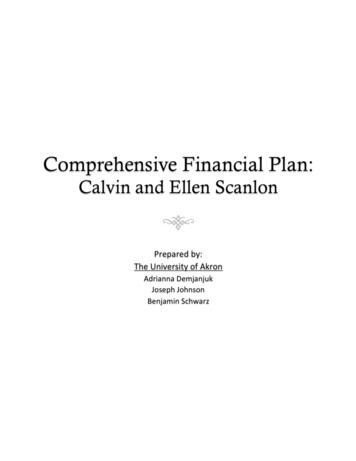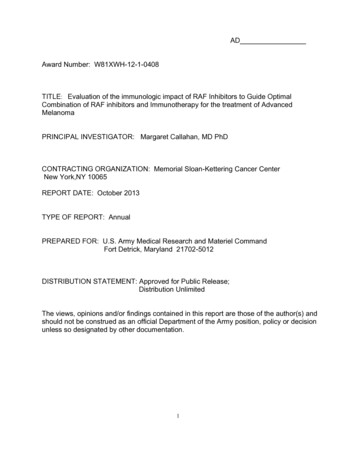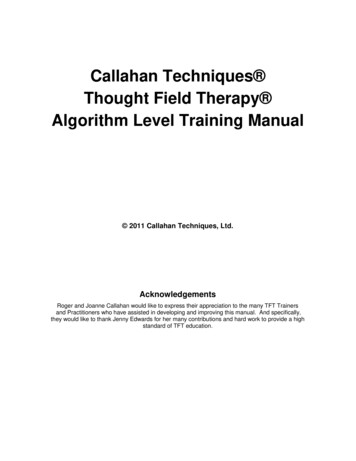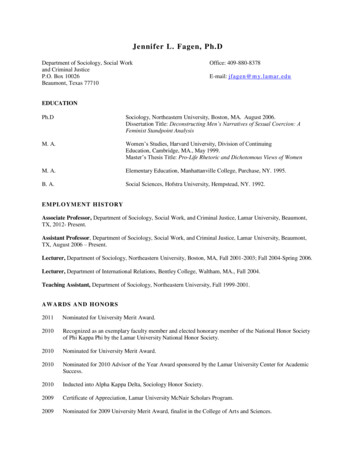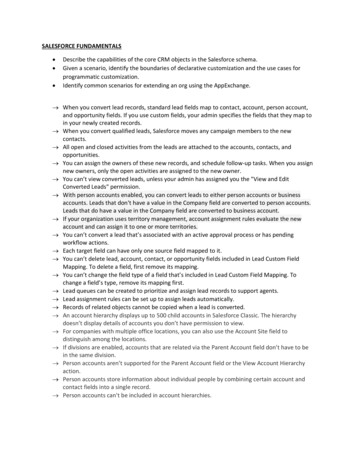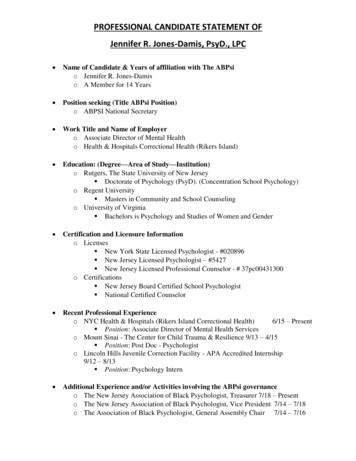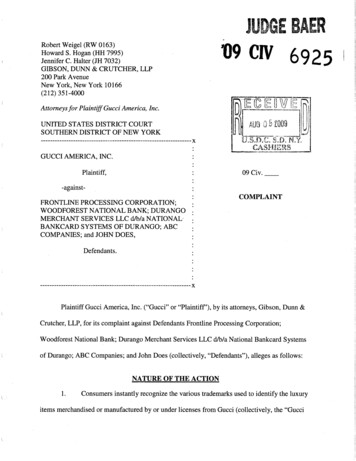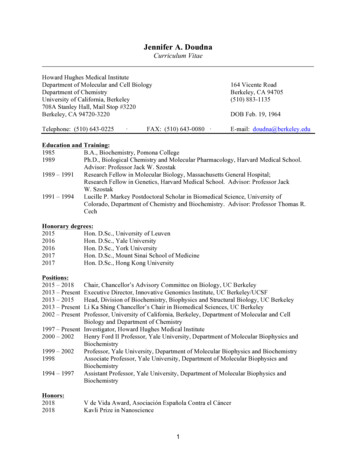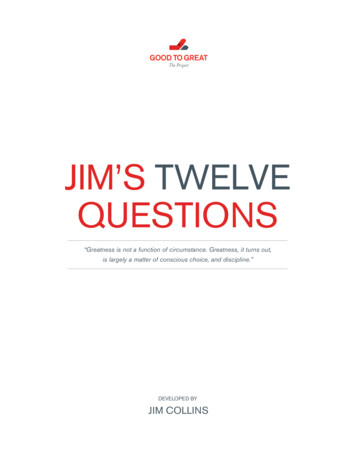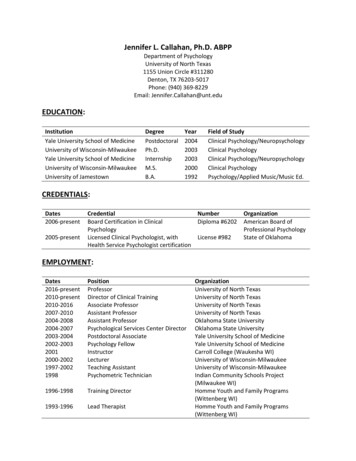
Transcription
Jennifer L. Callahan, Ph.D. ABPPDepartment of PsychologyUniversity of North Texas1155 Union Circle #311280Denton, TX 76203-5017Phone: (940) 369-8229Email: Jennifer.Callahan@unt.eduEDUCATION:InstitutionYale University School of MedicineUniversity of Wisconsin-MilwaukeeYale University School of MedicineUniversity of Wisconsin-MilwaukeeUniversity of Year20042003200320001992Field of StudyClinical Psychology/NeuropsychologyClinical PsychologyClinical Psychology/NeuropsychologyClinical PsychologyPsychology/Applied Music/Music tialNumberBoard Certification in ClinicalDiploma #6202PsychologyLicensed Clinical Psychologist, withLicense #982Health Service Psychologist certificationOrganizationAmerican Board ofProfessional PsychologyState of tor of Clinical TrainingAssociate ProfessorAssistant ProfessorAssistant ProfessorPsychological Services Center DirectorPostdoctoral AssociatePsychology FellowInstructorLecturerTeaching AssistantPsychometric Technician1996-1998Training Director1993-1996Lead TherapistOrganizationUniversity of North TexasUniversity of North TexasUniversity of North TexasUniversity of North TexasOklahoma State UniversityOklahoma State UniversityYale University School of MedicineYale University School of MedicineCarroll College (Waukesha WI)University of Wisconsin-MilwaukeeUniversity of Wisconsin-MilwaukeeIndian Community Schools Project(Milwaukee WI)Homme Youth and Family Programs(Wittenberg WI)Homme Youth and Family Programs(Wittenberg WI)
Last Updated: 8/20/2020Callahan p.2RESEARCH*graduate student co-author **undergraduate student co-authorAreas of Expertise:(1) Improving psychological services and client outcomes by elucidating contributing client and therapistvariables, as well as the role of training and supervisors, and (2) understanding distress and resiliencyfollowing exposure to trauma (including neuropsychological correlates).Peer-Reviewed Journal Articles:1. *Gregus, S. J., *Stevens, K. T., *Seivert, N. P., *Tucker, R. P., & Callahan, J. L. (in press). Studentperceptions of multicultural training and program climate in clinical psychology doctoral programs.Training and Education in Professional Psychology. doi: 10.1037/tep00002892. Schuler, K., Ruggero, C. J., Mahaffey, B., Gonzalez, A., Callahan, J. L., Boals, A.,Waszczuk, M. A., Luft,B., & Kotov, R. (in press). When Hindsight is Not 20/20: Assessment of PTSD Predominantly CapturesWorst, not Average, Symptoms. Assessment. doi: 10.1177/10731911198698263. Fett, A.J., Velthorst, E., Reichenberg, A., Ruggero, C.J., Callahan, J. L., Fochtmann, L.J., Carlson, G.,Perlman, G., Bromet, E.J., Kotov, R. (2020). Long-term changes in cognitive functioning in psychoticdisorders. Findings from the Suffolk County Mental Health Project. JAMA Psychiatry, 77, 387396. doi: 10.1001/jamapsychiatry.2019.39934. Callahan, J. L., Bell, D. J., Davila, J., Johnson, S. L., Strauman, T. J., & Yee, C. M. (2020). The EnhancedExamination for Professional Practice in Psychology: A Viable Approach? American Psychologist, 75,52-65. doi: 10.1037/amp00005865. Callahan, J. L. & Love, P. K. (2020). Introduction to the special issue: Supervisee perspectives onsupervision processes. Journal of Psychotherapy Integration, 30, 1-8. doi: 10.1037/int00001996. Watkins, Jr., C. E., Callahan, J. L., & Vîscu, L. (2020). The common process of supervision process:The supervision session pyramid as a teaching tool in the beginning supervision seminar. Journal ofContemporary Psychotherapy, 50, 15-20. doi: 10.1007/s10879-019-09436-57. *Dornbach-Bender, A., Ruggero, C. J., *Smith, P., Schuler, K., *Bennett, C. B., Neumann, C. S., &Callahan, J. L. (2020). Association of Behavioral Activation System sensitivity to lower levelfacets of positive affect in daily life. Personality and Individual Differences, 152, . doi:10.1016/j.paid.2019.1095708. Ruggero, C. J., Kotov, R., Hopwood, C. J., First, M., Clark, L. A., Skodol, A. E., Mullins-Sweatt, S. N.,Patrick, C. J., Bach, B., Cicero, D. C., Dochtery, A., Simms, L. J., Bagby, R. M., Krueger, R. F., Callahan,J. L., Chmielewski, M., Conway, C. C., DeClercq, B. J., Dornbach-Bender, A., Eaton, N. R., Forbes, M.K., Forbush, K. T., Haltigan, J. D., Miller, J. D., Morey, L. C., Patalay, P., Regier, D. A., Reininghaus, U.,Shackman, A. J., Waszczuk, M. A., Watson, D., Wright, A. G. C., & Zimmerman, J. (2019). Integrating adimensional, hierarchical taxonomy of psychopathology into clinical practice. Journal of Consultingand Clinical Psychology, 87, 1069-1084. doi: 10.1037/ccp00004529. Ruggero, C. J., Callahan, J. L., *Dornbach-Bender, A., Tackett, J. L., & Kotov, R. (2019). Disquiet innosology: A primer on an emerging, empirically-based approach to classifying mental illness andimplications for training. the Behavior Therapist, 42, 208-211.10. Watkins, Jr., C. E., Hook, J. N., Owen, J., DeBlaere, C., Davis, Jr., D. E., & Callahan, J. L. (2019).Creating and elaborating the cultural third: A doers-doing with perspective on psychoanalyticsupervision. American Journal of Psychoanalysis, 79, 352-374. doi: 10.1057/s11231-019-09203-411. Watkins, C. E., Jr., Hook, J. N., DeBlaere, C., Davis, D. E., Van Tongeren, D. R., Owen, J., & Callahan, J.L. (2019). Humility, ruptures, and rupture repair in clinical supervision: A simple conceptual
Last Updated: .26.27.Callahan p.3clarification and extension. The Clinical Supervisor, 38, 281-300. doi:10.1080/07325223.2019.1624996Callahan, J. L., *Love, P. K., & Watkins, Jr., C. E. (2019). Supervisee perspectives of supervisionprocesses: An introduction to the special issue. Training and Education in Professional Psychology,13, 153-159. doi: 10.1037/tep0000275*Kilmer, E. D., &*Villarreal, C., *Janis, B. M., Callahan, J. L., Ruggero, C. J., Kilmer, J. N., *Love, P. K.,& Cox, R. J. (2019) Differential early termination is tied to client race/ethnicity status. PracticeInnovations, 4, 88-98. doi: 10.1037/pri0000085*Al-Jabari, R., Murrell, A. R., Callahan, J. L., Cox, R. J., & *Lester, E. G. (2019). Do distress level andwaitlists impact termination in a training clinic? Training and Education in Professional Psychology,13, 127-137. doi: 10.1037/tep0000223Callahan, J. L. (2019). Master’s level accreditation in health services psychology: A primer to thespecial section with commentary. Training and Education in Professional Psychology, 13, 73-83. doi:10.1037/tep0000248Watkins, Jr. C. E., Hook, J. N., *Mosher, D. K., & Callahan, J. L. (2019). Humility in ClinicalSupervision: Fundamental, Foundational, and Transformational. The Clinical Supervisor, 38, 58-78.doi: 10.1080/0735223.2018.1487355*Carlew, A. R., *Schuler, K. K., Ruggero, C. J., Callahan, J. L., Luft, B. & Kotov, R. (2019). Factorstructure of the CVLT-II Short Form: Evidence from a trauma-exposed sample. Assessment, 26, 976983. doi: 10.1177/1073191118763726*Dornbach-Bender, A., Ruggero, C. J., Bain, K. M., *Smith, P., Schuler, K. L., *Smotherman, J. M., &Callahan, J. L. (2019). Attention for emotion associated with hypomanic personality traits: Eyetracking reveals a positive bias independent of mood. Neurology, Psychiatry and Brain Research, 32,30-35. doi: 10.1016/j.npbr.2019.03.006Callahan, J. L., *Maxwell, K., & *Janis, B. M. (2019). The role of overgeneral memories in PTSD andimplications for treatment. Journal of Psychotherapy Integration, 29, 32-41. doi:10.1037/int0000116*DeLisle, A., *Walsh, H. C., *Holtz, P. M., Callahan, J. L. & Neumann, C. S. (2019). Rape mythacceptance, male gender role norms, attitudes towards women, and psychopathic traits in a militarysample. Personality and Individual Differences, 144, 125-131. doi: 10.1016/jpaid.2019.03.005Boals, A., Bedford, L. A., & Callahan, J. L. (2019). Perceptions of change after a trauma and perceivedposttraumatic growth: A prospective examination. Behavioral Sciences, 9, 10. doi:10.3390/bs9010010Watkins, Jr., C. E., *Davis, E. C. & Callahan, J. L. (2018). On disruption, disorientation, anddevelopment in clinical supervision: A transformative learning perspective. The Clinical Supervisor,37, 257-277. doi: 10.1080/07325222.2017.14.18694Callahan, J. L. & Watkins, Jr., C. E. (2018). Evidence-based training: The time has come. Training andEducation in Professional Psychology, 12, 211-218. doi: 10.1037/tep0000204Callahan, J. L. & Watkins, Jr., C. E. (2018). The science of training I: Admissions, curriculum, andresearch training. Training and Education in Professional Psychology, 12, 219-230. doi:10.1037/tep0000205Callahan, J. L. & Watkins, Jr., C. E. (2018). The science of training II: Prepracticum and practicumtraining. Training and Education in Professional Psychology, 12, 231-244. doi: 10.1037/tep0000209Callahan, J. L. & Watkins, Jr., C. E. (2018). The science of training III: Supervision, competency, andinternship training. Training and Education in Professional Psychology, 12, 245-261. doi:10.1037/tep0000208Callahan, J. L., *Smotherman, J., *Dziurzynski, K., *Love, P. K., *Davis, E. C., Flores Niemann, Y., &Ruggero, C. J. (2018). Diversity in the professional psychology training-to-workforce pipeline: Results
Last Updated: .42.43.44.Callahan p.4from doctoral psychology student population data. Training and Education in ProfessionalPsychology, 12, 273-285. doi: 10.1037/tep0000203Swift, J. K., Callahan, J. L., Cooper, M. & *Parkin, S. R. (2018). The impact of accommodating clientpreference in psychotherapy: A meta-analysis. Journal of Clinical Psychology: In Session, 74, 19241937. doi: 10.1002/jclp.22680*Gerber, M. M., *Kilmer, E. D., & Callahan, J. L. (2018). Psychotherapeutic yoga demonstratesimmediate positive effects. Practice Innovations, 3, 212-225. doi: 10.1037/pri0000074Swift, J.K., Callahan, J.L., *Dunn, R., *Ivanovic, M., & *Brecht, K. (2017). A randomized-controlledcrossover trial of mindfulness training for student therapists. Training and Education in ProfessionalPsychology, 11, 235-242. doi: 10.1037/tep0000154*Dunn, R. A., Callahan, J. L., Farnsworth, J. K., & Watkins, Jr., C. E. (2017). A proposed framework foraddressing supervisee-supervisor value conflict. The Clinical Supervisor, 36, 203-222. doi:10.1080/07325223.2016.1246395*Price, S. D., Callahan, J. L., Cox. R. J. (2017). Psychometric investigation of competency benchmarks.Training and Education in Professional Psychology, 11, 128-139. doi: 10.1037/tep0000133Callahan, J. L., Neumann, C. S., Cox, R. J., & Ruggero, C. J. (2017). The Supervisor Trainee QuarterlyEvaluation (STQE): Psychometric support for use as a measure of competency. Training andEducation in Professional Psychology, 11, 117-127. doi: 10.1037/tep0000140*Gerber, M. M., Callahan, J. L., *Moyer, D. M., *Connally, M. L., *Holtz, P. M., & *Janis, B. M. (2017).Bhutanese refugees reap support through community gardening. International Perspectives inPsychology: Research, Practice, Consultation, 6, 17-31. doi: 10.1037/ipp0000061*Wrape, E. R., Callahan, J. L., Rieck, T. & Watkins, Jr., C. E. (2017). Attachment theory within clinicalsupervision: Application of the conceptual to the empirical. Psychoanalytic Psychotherapy, 31, 3754. doi: 10.1080/02668734.2016.1261927*Price, S. D., & Callahan, J. L. (2017). Religious attendance serves as a protective variable againstsuicidal ideation during treatment. Pastoral Psychology, 66, 103-115. doi: 10.1007/s11089-0160725-1*Janis, B. M., Callahan, J. L., *Shelton, A. J., Aubuchon-Endsley, N. L. (2016). Birth complications andparental stress reactions: Moderated by family coping. Practice Innovations, 1, 243-252. doi:10.1037/pri0000032Watkins, Jr., C. E., & Callahan, J. L. (2016). How does psychoanalytic supervision work? A briefcommunication. The Scandinavian Psychoanalytic Review, 39, 46-50. doi:10.1080/01062301.2016.1218599Watkins, Jr., C. E., *Davis, E., *Love, P. & Callahan, J. L. (2016). Supervisor allegiance as a criticalconstruct: A brief communication. American Journal of Psychotherapy, 70, 439-440.*Maxwell, K., Callahan, J. L., *Holtz, P., *Janis, B. M., *Gerber, M. M. & *Connor, D. R. (2016).Comparative study of group treatments for posttraumatic stress disorder. Psychotherapy, 53, 433445. doi: 10.1007/s10896-015-9765-zParent, M. C., *Bradstreet, T. C., Wood, M., Ameen, E. J., & Callahan, J. L. (2016). “The worstexperience of my life”: The internship crisis and its impact on students. Journal of ClinicalPsychology, 72, 714-742. doi: 10.1002/jclp.22290*Wrape, E. R., Jenkins, S.R., Callahan, J. L., & *Nowlin, R.B. (2016). Emotional and cognitive coping inrelationship dissolution. Journal of College Counseling, 19, 110-119. doi: 10.1002/jocc.12035*Hogan, L. R., Callahan, J. L., & *Shelton, A. J. (2016). Una cuestión de percepción: Impacto dediferencias de valores entre paciente y terapeuta sobre alianza y resultados [A matter of perception:Patient and therapist value differences impact working alliance and outcome]. Revista Argentina deClínica Psicológica [Journal of Clinical Psychology Argentina], 25, 5-16.*Wrape, E. R., ***Dittloff, A. L., & Callahan, J. L. (2016). Gender and musical instrument stereotypes
Last Updated: .59.60.61.Callahan p.5in middle school children: Have trends changed? UPDATE: Applications of Research in MusicEducation, 34, 40-47. doi: 10.1177/8755123314564255*Maxwell, K., Callahan, J. L., Ruggero, C. J., *Janis, B. (2016). Breaking the cycle: Association ofattending therapy following childhood abuse and subsequent perpetration of violence. Journal ofFamily Violence, 31, 251-258. doi: 10.1007/s10896-015-9765-z*Ivanovic, M., Swift, J. K., Callahan, J. L., & *Dunn, R. (2015). A multi-site pre/post study ofmindfulness training for therapists: The impact on session presence and effectiveness. Journal ofCognitive Psychotherapy, 29, 331-342. doi: 10.1891/0889-839.29.4.331Watkins, Jr., C. E., Budge, S. L., & Callahan, J. L. (2015). Common and specific factors converging inpsychotherapy supervision: A supervisory extrapolation of the Wampold/Budge psychotherapyrelationship model. Journal of Psychotherapy Integration, 25, 214-235. doi: 10.1037/a0039561Swift, J. K., Callahan, J. L., *Tompkins, K. A., *Connor, D. R., & *Dunn, R. (2015). A delay-discountingmeasure of preference for racial/ethnic matching in psychotherapy. Psychotherapy, 52, 315-320.doi: 10.1037/pst0000019*Connor, D. R., & Callahan, J. L. (2015). Impact of psychotherapist expectations on client outcomes.Psychotherapy, 53, 351-362. doi: 10.1037/a0038890Swift, J. K., Callahan, J. L., Rousmaniere, T. G., Whipple, J. L., Dexter, K., & *Wrape, E. R. (2015).Using client outcome monitoring as a tool for supervision. Psychotherapy, 52, 180-184. doi:10.1037/t00830-000Callahan, J. L. (2015). Health policy: Is it feasible and what’s the evidence? Training and Education inProfessional Psychology, 9, 128-131. doi: 10.1037/tep0000086*Rieck, T., Callahan, J. L., & Watkins, Jr. C. E. (2015). Clinical supervision: An exploration of possiblemechanisms of action. Training and Education in Professional Psychology, 9, 187-194. doi:10.1037/tep0000080; 10.1037/tep0000080.supp (supplemental)*Rieck, T., Hausdorf, P., & Callahan, J. L. (2015). The role of emotional intelligence in peerinstructional dyads. Scholarship of Teaching and Learning in Psychology, 1, 24-37. doi:10.1037/stl0000018*Nichols, E., Callahan, J. L., & Neumann, C. (2015). Variations in suicidal ideation among substanceusers. Suicidology Online, 6, 21-32.*Cawston, A., Callahan, J. L., & *Wrape, E. R. (2015). Pre-practicum training to facilitate socialinference competency. Training and Education in Professional Psychology, 9, 28-34. doi:10.1037/tep0000069Callahan, J. L. (2015). Evidence-based technical skills training in pre-practicum psychologicalassessment. Training and Education in Professional Psychology, 9, 21-27. doi: 10.1037/tep0000061as well as 10.1037/tep0000061.supp*Wrape, E. R., Callahan, J. L., Ruggero, C. J., & Watkins, Jr. C. E. (2015). An exploration of facultysupervisor variables and their impact on client outcome. Training and Education in ProfessionalPsychology, 9, 35-43. doi: 10.1037/tep0000014Rambo, P. L., Callahan, J. L., *Hogan, L. R., *Hullman, S. E., & *Wrape, E. (2015). Effort testing inchildren: Can cognitive and symptom validity measures differentiate malingered performances?Applied Neuropsychology: Child, 4, 1-8. doi: 10.1080/21622965.2013.780238Aubuchon-Endsley, N. L., Callahan, J. L., *González, D. A., Ruggero, C. J., & Abramson, C. I. (2015).The impact of hope in mediating psychotherapy expectations and outcomes: A study of Brazilianclients. International Journal of Integrative Psychotherapy, 6, 63-80.*Aubuchon-Endsley, N. L., Callahan, J. L., & **Scott, S. (2014). Role expectancies, race, andtreatment outcome in rural mental health. American Journal of Psychotherapy, 68, 339-354.*Heath, C. J., & Callahan, J. L. (2014). Assessment of cognitive functioning in mixed martial artsathletes. Journal of Athletic Enhancement, 3(4), 1-5. doi: 10.4172/2324-900.1000162
Last Updated: 8/20/2020Callahan p.662. **Gerber, M. M., *Hogan, L. R., *Maxwell, K., Callahan, J. L., Ruggero, C. J., & Sundberg, T. (2014).Children after war: A novel approach to promoting resilience through music. Traumatology, 20, 112118. doi: 10.1037/h009939663. Callahan, J. L., Gustafson, S., Misner, J., Paprocki, C. M., Sauer, E., Saules, K. K., Schwartz, J., Swift, J.K., Whiteside, D., Wierda, K., & Wise, E. H. (2014). Introducing the Association of Psychology TrainingClinics’ Collaborative Research Network: A Study on Client Expectancies. Training and Education inProfessional Psychology, 8, 95-104. doi: 10.1037/tep000004764. *Wisdom, N.M., *Connor, D.R., *Hogan, L.R., & Callahan, J.L. (2014). The relationship of anxiety andbeliefs toward aging in ageism. Journal of Scientific Psychology, 9, 10-21.65. Aubuchon-Endsley, N. L. & Callahan, J. L. (2014). Exploring pretreatment expectancies in a campusmental health setting. Journal of College Counseling, 17, 64-79. doi: 10.1002/j.21611882.2014.00048.x66. Callahan, J. L., *Hogan, L. R., Klonoff, E. A., & Collins, F. L., Jr. (2014). Predicting match outcomes:Science, practice, and personality. Training and Education in Professional Psychology, 8, 68-82. doi:10.1037/tep000003067. Callahan, J. L., Borja, S. E., *Herbert, G. L., *Maxwell, K., & Ruggero, C. J. (2013). Test of the TraumaOutcome Process Assessment model: One model of individual and environmental factors to explainadjustment. Traumatology, 19, 268-279. doi: 10.1177/153476561347609868. Callahan, J. L., Ruggero, C. J., & Parent, M. C. (2013). Hidden gems among clinical psychologytraining programs. Training and Education in Professional Psychology, 7, 278-284. doi:10.1037/a003423369. Ruggero, C. J., Kotov, R., Callahan, J. L., *Kilmer, J., Luft, B., & Bromet, E. J. (2013). PTSD symptomdimensions and their relationship to functioning in World Trade Center responders. PsychiatryResearch, 210, 1049-1055. doi: 10.1016/j.psychres.2013.08.05270. Callahan, J. L., *Heath, C. J., Aubuchon-Endsley, N. L., Collins Jr., F. L., *Herbert, G. L. (2013).Enhancing information pertaining to client characteristics to facilitate evidence-based practice.Journal of Clinical Psychology, 69, 1239-1249. doi: 10.1002/jclp.2199571. *Dunn, R., Callahan, J. L., & Swift, J. K. (2013). Mindfulness as a transtheoretical clinical process?Psychotherapy, 50, 312-315. doi: 10.1037/a003215372. *Tompkins, K. A., Swift, J. K. & Callahan, J. L. (2013). Working with clients by incorporating theirpreferences. Psychotherapy, 50, 279-283. doi: 10.1037/a003203173. *Herbert, G. L., Callahan, J. L., Ruggero, C. J., & Murrell, A. R. (2013). New analyses of the NationalInstitutes of Mental
Yale University School of Medicine Internship 2003 Clinical Psychology/Neuropsychology University of Wisconsin-Milwaukee M.S. 2000 Clinical Psychology University of Jamestown B.A. 1992 Psychology/Applied Music/Music Ed. CREDENTIALS: Dates Credential Number Organization 2006-present Bo
